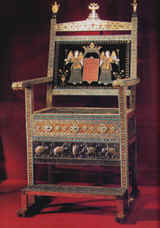|
|
In 1967, Diamond Collection Exhibition Hall, housing one of the largest collections of jewels, was opened on the first floor of the Armoury.
The pride of Diamond Collection is historical relics such as state regalia, unique precious stones and articles made thereof. This is part of the royal treasures, which were previously kept in Diamond Room of Winter Palace in St. Petersburg. These treasures were shown for the first time at Moscow’s Column Hall, in 1925.
Exhibition introduces the visitors to the outstanding works of jeweler of 18th-19th century. Considerable number of the exhibits dates from the mid-18th century and gives vivid idea of the jeweler art in the baroque and rococo styles.
Sparkling diamonds, glowing rubies, sapphires, emeralds and olive-green chrysalides enhance the decorative effect. In combination with their whimsical shapes and exquisite ornamentation, the stones produce an impression of sumptuousness and resplendence typical of the era of Empress Yelizaveta Petrovna (1741-1761).
In 18th century jewelers were inspired by nature itself and tried to reproduce the wealth of color of the surrounding environment in sparkling gemstones. Bouquets, diadems, earrings, aigrettes and bow necklace are delicate yet inimitable in their beauty.
Jewelers attained the impressive wealth of colors of the gemstones in Great Bouquet, by using the popular method of tinting diamonds with special foil. Loosely fastened flowers produce an interesting effect.
The aigrette and earrings, which are shaped as diamond fountains, with big dark blue Ceylon sapphires on their tips, are uncommonly well designed.
The St. Petersburg jeweler, Pfisterer, made the bow-necklace with precious spinal, in 1764. Diamonds combined with larger spinal stones form delicate lacy pattern producing an impression of lightness despite the considerable weight of the piece.
Since the last third of 18th century, jewelers gave preference to the diamond, a favorite of the court fashions of that time. Cherry-shaped earrings can serve as fine example as the two large diamonds look like cherries on diamond grafts.
Women's fashion accessories such as hairpins shaped as bows, cornucopias and baskets with roses set among the leaves show rich imagination and as absolutely faultless sense of style.
Russian State Regalia consisting of the crown, orb and scepter demonstrate an exceptionally high level of craftsmanship.
In 1762, talented court jeweler, named Jeremia Posier, for the coronation of Empress Catherine II, made the great crown. It has traditional shape, because it consists of two openwork hemispheres divided by foliate garland and fastened with low hoop. The cold sparkling of 5000 diamonds, which decorate the crown, is shaped by the mat radiance of large beautiful pearls. The crown is decorated with one of the seven historic stones of Diamond Collection, precious spinal weighing 398.72 carats, which was brought to Russia by Nikolai Spafari, the Russian envoy to China.
The gold orb was also made in 1762. It is polished ball with a cross and is encircled with two rows of large diamonds.
The gold scepter was decorated by diamond called “Orlov”, in 1774. It is the world's fourth largest diamond and weighs 189.62 carats.
In 1801, Duval brothers made a minor diamond crown for Yelizaveta Alexeyevna, the wife of Alexander I. They were well-known jewelers of the late period of classicism and expressed the aesthetic requirements of their time.
Flat diamonds are extremely rare. One of them is a diamond called “Taffelstine”, weighing 25 carats, with miniature portrait of Alexander I underneath.
Another historic stone is a diamond called “Shah” (weighing 88.7 carats), which came down to Russia in its natural form. It was discovered in India in 16th century and was regarded a talisman. Its three facets bear inscriptions in Persian made by its owners, which help reveal its amazing story. In 1829, the stone was presented to Emperor Nicholas I, by the envoys of Persian crown-prince Khozrev-Mirza “in redemption of the murder of the white ambassador”, as Tehran newspapers wrote referring to the great Russian poet A. Griboyedov.
There is unique stones, Ceylon sapphire weighing 258.8 carats and large cubic Columbian emerald weighing 136.25 carats in diamond brooches, which date from the first half of 19th century.
Olive-green chrysalides, weighing 192.6 carats, is another of the historic stones. It was found on the volcanic island of Zaberget in Red Sea.
Russian state decorations studded with gemstones take the pride of Diamond Collection. It includes a diamond chain and a star of the first Russian Order of St. Andrew, the Order of St. Catherine, the Order of Alexander Nevsky and a foreign Order of the Golden Fleece.
Those sections of the exhibition, which house national diamonds from various deposits, are very interesting. There are cut diamonds and unique collection of giant diamonds, the smallest of which weighs 20 carats and the largest, Yakutian diamond, weighs 342.57 carats. The latter was found in 1980.
Diamond Collection possesses many works by well-known modern jewelers. Their works often reflect the best traditions in the development of this art over past centuries. Unique fusion of technical skill, rich imagination and artistic taste is demonstrated by the open work brooch called “Rose”, which is “woven” out of 1500 diamonds, by the majestic diadem “Russian Beauty” and other articles decorated with precious stones such as emeralds, amethysts and pearls.
A unique collection of nuggets of noble metals from various national deposits such as 20 nuggets of platinum and 100 of gold crowns this collection of fabulous treasures. The largest nugget of gold, which was found in the Urals in 1842, weighs 36kg, and the largest find of platinum weighs 7,800 grams.
The exhibition wins the hearts of visitors with the craftsmen’s talent and the beauty of their creations, an unfading heritage of art culture.

|
|

